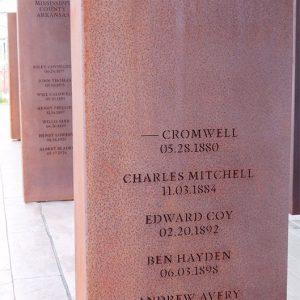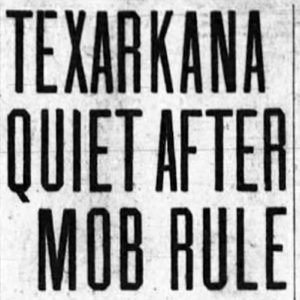calsfoundation@cals.org
Hurley Owen (Lynching of)
Hurley Owen, an African-American man, was lynched in Texarkana (Miller County) on May 19, 1922, in front of a mob numbering in the thousands for the alleged crime of murdering a local police officer. His body was subsequently burned.
Hurley Owen (or Hullen Owens, as his name was sometimes reported) had been arrested on Thursday, May 18, 1922, on a charge of stealing automotive parts. The following afternoon, he reportedly told Patrolman Richard C. Choate and Police Chief L. J. Lummus that he was willing to show them where he had hidden away more stolen goods. They followed him into an alley, where he pulled a .45 caliber pistol from a trash bin. According to the Arkansas Democrat, Lummus then shot Owen in the face, but Owen fled three blocks, pursued by the officers, before turning his gun upon Choate and shooting him six times. However, the Gazette reported that Owen had fired first, striking Choate, who, despite being mortally wounded, managed to fire back, hitting Owen in the mouth. Both newspapers agree that Owen was able to make his escape in an automobile, which he abandoned outside Texarkana and subsequently attempted to drown himself, fearing capture.
Miller County’s sheriff, John Strange, managed to pull Owen from the water and take him to the hospital. While Owen was being treated, large crowds began to congregate outside the building. The sheriff and his men were able to move Owen to the county jail, but at approximately 8:20 p.m., a large mob stormed the jail, using an iron battering ram to break down the heavy door. Owen was reportedly only semi-conscious as he was dragged outside, still on his cot. Sheriff Strange and Judge H. M. Barney reportedly tried to disperse the mob, to no effect. The Democrat reported that Owen was strangled outside, but the Gazette reported that he was taken to Offenhauser Park in the center of the city and shot to death, adding, “Several thousand persons, mostly men, witnessed the lynching. However, only a few hundred participated.” After Owen was killed, the body was taken to the local railroad depot and set on fire. (Another Texarkana lynching, that of Edward Coy in 1882, also included the burning of the victim, but in Coy’s case it happened while he was still alive.)
A coda in the Gazette reporting reflected rumors that local African Americans in Texarkana intended to “get revenge,” and that hardware stores and other businesses remained open late so that worried whites could arm themselves, but nothing came of these rumors.
Unlike other lynchings, especially those perpetrated against African Americans, the supposed leaders of the mob were arrested the following month. The Democrat reported the arrest of seven men from both the Arkansas and Texas side of the border: Nick Hightower, Joe Carter, John Elmore, Dick Farr, Joe Ransom, D. E. Burns, and Will May. Two others were later added: Dave Orr and I. V. Hill. The charge was first-degree murder. Burns and May were prominent Miller County farmers, and many of the others held respectable jobs. By December, however, it was reported that the attorneys for the defendants had been granted a continuance until the June term of the court, and it does not appear that the case ever actually went to trial.
For additional information:
“Alleged Lynchers under Indictment.” Arkansas Gazette, June 11, 1922, p. 1.
“Cases Are Continued.” Arkansas Gazette, December 15, 1922, p. 17.
“Jail Stormed; Negro Lynched.” Union Daily Times (Columbia, South Carolina), May 22, 1922, p. 1.
“Seven Are Held as Leaders in Lynching.” Arkansas Democrat, June 11, 1922, p. 1.
“Texarkana Negro Is Victim of Mob.” Arkansas Democrat, May 20 1922, p. 1.
“Texarkana Quiet after Mob Rule.” Arkansas Gazette, May 20, 1922, p. 1.
Staff of the CALS Encyclopedia of Arkansas
 Civil Rights and Social Change
Civil Rights and Social Change Early Twentieth Century, 1901 through 1940
Early Twentieth Century, 1901 through 1940 Miller County Lynching
Miller County Lynching  Owen Lynching Article
Owen Lynching Article  Owen Lynching Article
Owen Lynching Article 




Comments
No comments on this entry yet.